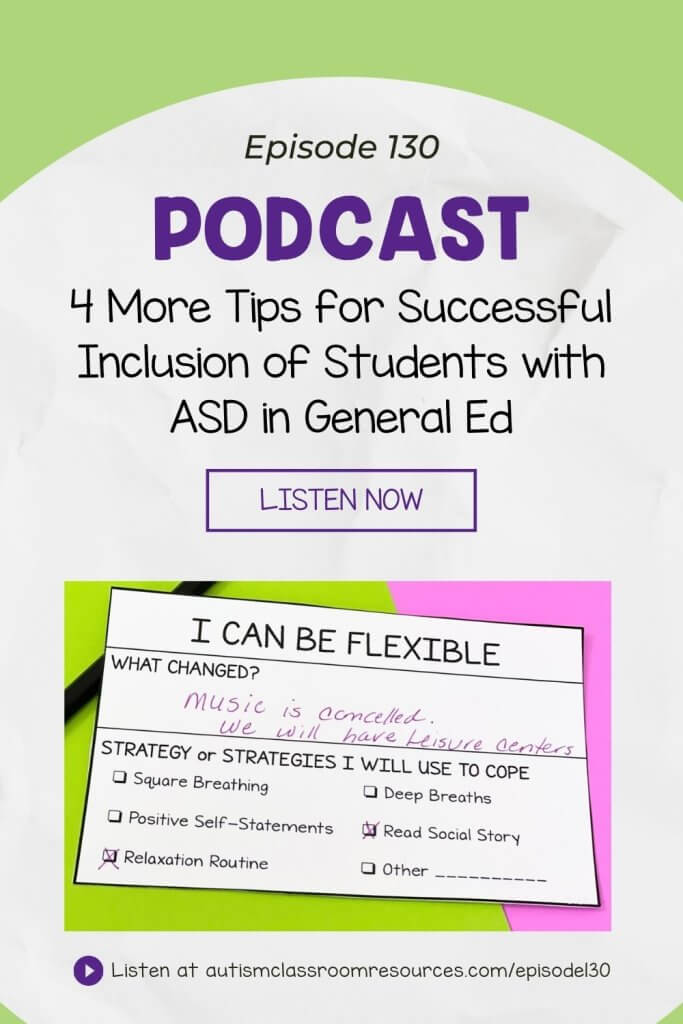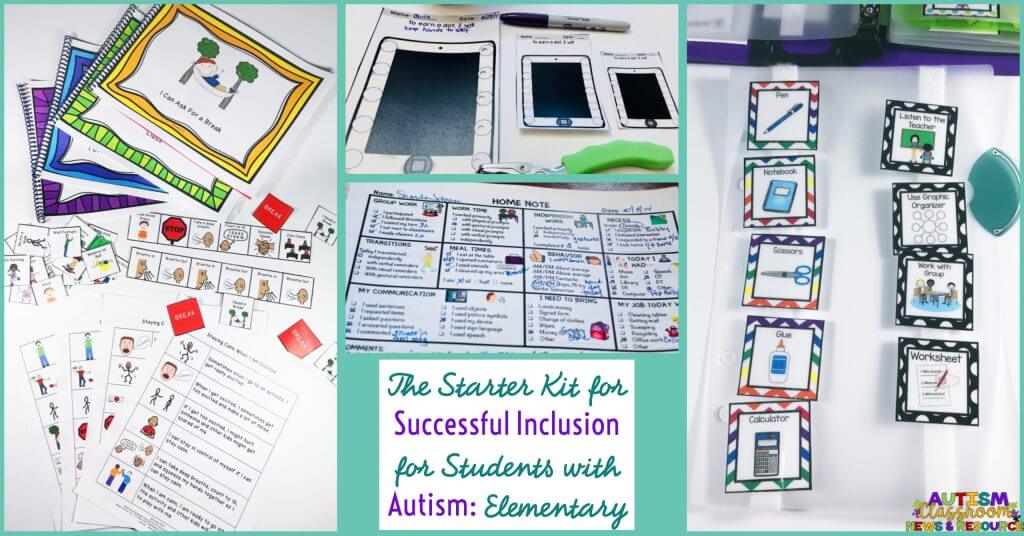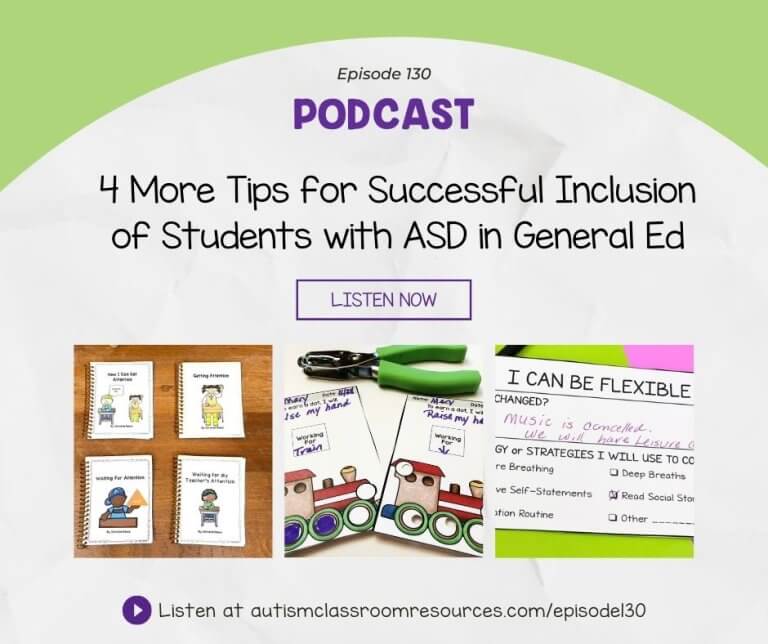Welcome to the Autism Classroom Resources Podcast, the podcast for special educators who are looking for personal and professional development.
Christine Reeve: I’m your host, Dr. Christine Reeve. For more than 20 years, I’ve worn lots of hats in special education but my real love is helping special educators like you. This podcast will give you tips and ways to implement research-based practices in a practical way in your classroom to make your job easier and more effective.
Welcome back. I am Chris Reeve and I’m your host. I’m very excited that you’re here. We are continuing on from our episode last week that we started talking in Episode 129 with the first three tips for successfully including students with disabilities in gen ed environments.
Today, we are going to continue with more tips. We’re talking about students, whether they are included fully in a general ed environment or included for things like specials or specific classes or things like that. I’m talking about students with autism, students with behavioral issues, students with intellectual disabilities, students who often have more difficulty than just students with learning disabilities, students who may have behavioral issues that make it difficult for them sometimes in a larger general ed environment.
Today, I’m going to talk about, I think, three more tips that I have for you today that really focus on how do we plan and organize for them to help them be as successful as they can be in those environments and really organize and get them set up for success. That’ll be what we are talking about today.
I just want to share with you too, that based on these strategies that I’m going to talk about today, that I talked about last week, I have a toolkit in my TPT store that is a toolkit for successful inclusion that is actually designed with a lot of these strategies in mind. A lot of the behavioral supports, a lot of the visual supports that I talk about are all in that set. It’s just one big bundle that allows you to make sure that you’ve got the visual supports, the behavioral supports, the social stories that a lot of our children in elementary school are going to need to be successful.
I’m also in the process of working on one for students who are older that will need those kinds of supports as well. Hopefully that will make it out before this fall. I will leave a link to that in the show notes so that you can check that out in my store if you’re interested. Let’s go ahead and get started.
Our next tip is that we want to be proactive with behavior. Just like in my last episode, I talked about the fact that we want to make sure our students are going out of the special ed classroom and out into the larger environments with the visuals, that if they have the visuals for support in our classrooms in special ed, they’re going to need them even more outside, the same is true with behavior.
If we’re thinking about the kinds of behavior supports that our students need in our classrooms, they’re going to need more behavioral support when they go out into a broader environment. Here’s a quick checklist that I would think about going through to think about what you want to include when a student is going out even if it’s just PE and recess or the lunchroom, but also if they’re going into music and art, but also if they’re going into kindergarten circle time or they’re going to the track meet or they’re going to social studies or whatever else it is.
Does the student have behavioral issues that might keep him from participating in the general ed environment or activity? If so, has a functional behavior assessment been done? If you’re not sure what that is, you can go search on my blog, there’s a ton of information about that. If an FBA has been done, is there a behavior plan? If the answer is no, do both of those. I’ll make sure there’s information about those in the blog post that goes with this episode.
If there is a behavior plan, does everyone supporting the student know how to implement it? If not, then we need to make sure that they are aware of those documents, that they understand it, and that we’ve trained them in how to use it. What elements are in the students’ behavior plan and how can you implement them in other classrooms? Was the behavior plan just written for special ed and do we need to make adaptations to it for other environments? If he needs it with the special ed classroom, he’s going to need something even more supportive in the larger environment.
Does he need work assigned in small pieces, for instance? Does he get overwhelmed when you give him a whole worksheet? Well, if that’s the case, we need to know that when he goes into math in the general ed fifth grade class. We want to make sure that they know to break his work down in other places. We need to make sure that information gets transferred to the right people.
Are there problems that don’t occur in the special ed class, or haven’t for a long time, but that might occur in a larger setting? If so, what supports are needed? Are there things that you haven’t seen in a long time but that might be because your classroom might be quieter and doesn’t have as much stuff going on? There’s not that noise or the activity that might be a problem.
Does he need earbuds or headphones that he doesn’t need in your class because it’s quieter that he might need in another place? Does he need a quiet place to take a break in a bigger setting when it becomes overwhelming that maybe he hasn’t needed in your class all year? Think about those things ahead of time.
Don’t wait for a problem to happen in that setting. So many times I talk to people and they’re like, “Well, we wanted to give him the benefit of the doubt and we thought this behavior problem had gotten better so we wanted to go see how he was going to do.” It’s a great thought and I get it but the problem is that then you may be setting him up to then set himself up.
Because if he goes there and he has a problem, he’s going to have that problem in front of his whole class. That’s going to give him an embarrassing moment at the least, a problem at the most, where he ends up getting in trouble or having to be removed. It’s just not going to be a good thing.
Now he’s going to have a problem if you’ve set up a quiet corner in the room where he could escape to if he never needs to use it. If he never needs to use it, yay team, that’s awesome, nobody needs to know it’s his. He just needs to know it’s his. Maybe he never has to use it but if you have it and don’t use it, you’re good. But if you don’t have it and he needs it and he falls apart, you take four steps backwards. Be proactive to help him be successful from the start and get off to a really good start in that situation.
Another one is to think about reinforcement. This is the same principle. First of all, if you’re using any kind of reinforcement with him, whether it’s for some kids, it is edible reinforcers, for some of our students, it is concrete reinforcers, time with an iPad, time with a particular toy that he likes.
For some of our students, they might be on a token system or a point system. Make sure you take those systems with you because again, if it stays in the special ed room, it’s not going to help him in a larger environment. When he goes into a more complex situation, he needs more reinforcement, not less. He needs more reinforcement in a new environment.
You may also need to reinforce behaviors that maybe you didn’t need to reinforce in your room for a long time because he’s around less familiar situations, less familiar people. It needs more reinforcement for behaviors that maybe you haven’t had to reinforce in a while. Use your reinforcers for appropriate behavior and academic success.
Maybe you feel like it’s taking a step backwards to reinforce behaviors you haven’t had to reinforce in a while, but again, to help them be successful, you can always fade it out really quickly, but better to step back and reinforce more than you have to and then fade it out than to think you don’t need it and then discover that you do and you don’t have it.
However you’re reinforcing in the special ed setting, think about reinforcing more to start with outside the special ed setting. That includes whether it’s the hall, recess, specials, or math. More complex environments are generally going to need higher levels of reinforcement, your token board, your point cards, or just random reinforcement, just “I see you’re doing a great job, here’s token.”
Have the staff in the larger setting, give the reinforcers so that they get paired with reinforcement. Don’t always have special ed staff be the only ones giving the reinforcers. You want eventually, hopefully, to maybe fade that staff out. Have the staff in their classrooms give the reinforcers so that they become the same as the special ed staff.
You may want to use your most powerful reinforcers in those environments if you can. I know that’s not always a possibility. They may not have access to a computer that they can use in that environment if that’s the most powerful reinforcer. You want to think about those kinds of things.
Another thing you want to think about is training your peers. We often forget about this step but it’s really important that we have developed a set of typical peers who could be good models for the student. With good research that indicates that just having students, especially for students with autism but I think it’s true for a lot of our other students, just having students with autism in a classroom sitting next to typical peers does not result in increased skills of any kind. Just having students out on a playground with typical peers did not change them. It did not make them more social, it did not make them good playmates, it did not increase their social behavior.
It actually led to very little interaction between kids with autism and typical kids. To get learning, you need interaction. To get interaction, the peers need to know how to interact effectively. Sometimes that can be a challenge if your kids have social issues. It might mean that they need to know things like how to wait for your students to respond.
I’ll never forget a student I worked with that they needed to know that when they were the leader, they needed to encourage them to follow them because they didn’t know that my kid didn’t know how to do that. They were halfway down the hallway and didn’t know that the kid wasn’t following because they didn’t know that the kid didn’t know to follow them.
Our kids often process more slowly so they need some time to process and the peers need to know that. How to model a skill and wait for a student to copy them, that they’re actually teaching that skill. That sometimes our students communicate with pictures and that they should use those pictures and those devices to communicate back, that’s a training skill that we need to teach, to use that assistive technology back with them, to use that aided modeling.
There are lots of other things that we need to teach. That’s like a whole other post. We need to use some strategies for training peers as well. We can do reverse inclusion. Before our students go out into their classroom, maybe we could pull in a small group of peers to the special ed classroom to let them get to know your students and let your students get to know them. That allows you to facilitate and teach that small group of students.
Select a small group of four to six students who like your kids, and use recess or lunch as a way to strategically set up opportunities for them to learn to interact. If you’ve got inside recess, especially in the winter months, use that time to have them rotate through your classroom that way. Choose a set of four to six students in a gen ed class and spend the first part of the year structuring interactions with a student with disabilities with each of them so that they become independent in their interactions and then you can fade out so they can interact more naturally.
There’s a ton of things that you can do. That’s like a whole course by itself. It’s more than a podcast. But those are just some things that you can think about doing. Finally, in addition to training your peers, make sure you train your staff. It’s certainly not the last step. I should not say that’s the last thing you should do. It’s no less important just because I put it last. But it is critical to train your staff in how to facilitate meaningful participation with the students in the general ed class.
How to communicate and collaborate with the general educators? Sometimes that means training general ed about your kids’ disabilities as well as strategies to use to support them. It means training general educators and it means training staff that you work with on how to go in to the classroom. Show them how visual schedule works so they can use it in their classroom. Show them how to reinforce and have them practice so they become a conditioned reinforcer.
Brainstorm with them about some ways to modify and accommodate assignments successfully. Make sure they know what information they can share about a student and how to handle other students’ questions about that child. Those are just some of the things that you can do. There certainly are a ton more, and obviously, I could go on forever and ever and ever. But those are some things to get you started. Those are some things you can do proactively before the students ever start doing this to be as successful as possible, to set up and organize the classroom environments to help your students be as successful as possible.
I would love to hear your questions, and answer hopefully your questions if I have answers in our Facebook group at specialeducatorsconnection.com. Definitely come over if you’re a teacher or a paraprofessional. Definitely come and answer the questions and we would love to get you in there and get you talking with us about this. Come and share.
I would love to have you come back next week when we will actually be talking about a new topic. I have no idea at the moment what it is but I’m sure it will be something about back to school. I hope that you will come and join us then. Until then, I will be here thinking about whatever the next topic is going to be and I hope that you have an amazing week.







